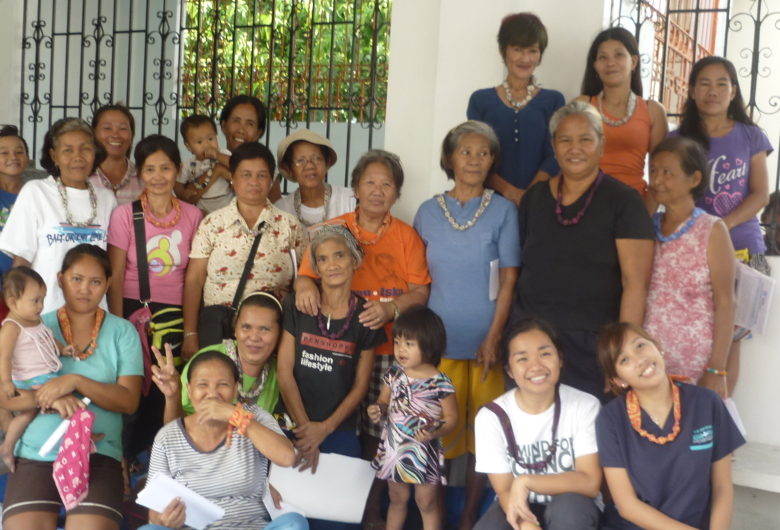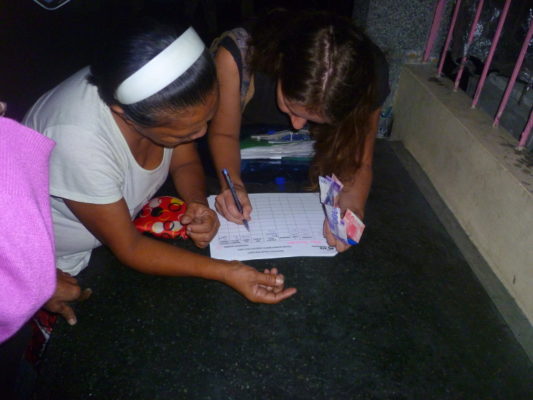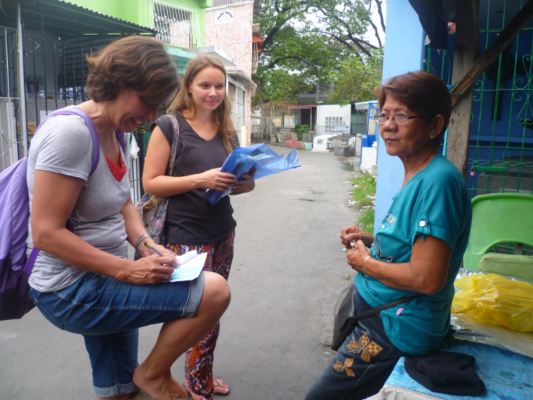“Sulong” – Savings Program That Works for Everyone

In early May 2018, ATD featured articles about its economic development projects that focus on people living in extreme poverty who are not part of the traditional world of work. These articles demonstrate the kinds of programmes and conditions needed to benefit those in extreme poverty.
ATD Fourth World has been in the Philippines for several decades. In Manila, the capital city, many families with nowhere else to go live in the North Cemetery where they earn a little money taking care of tombs and mausoleums, and offering other services to visitors. In 2015, ATD’s Volunteer Corps working in Manila helped start a new pilot program with families there. It was called “Sulong”, the Philippine word for “Let’s move forward!”
The ATD Volunteer Corps Members noticed that the topic of work and money came up regularly in conversations with families living in the cemetery. There were many concerns about finding work, low pay, and being rehoused in areas where there were no jobs. When families needed money urgently, they had to pawn items or borrow from money-lenders who charged very high interest rates. At times like All Saints Day, some were able to earn a good deal of money. But using a bank to save was unthinkable for them because they lacked identification documents or proof of income. Some people were afraid to put money aside for fear it would be stolen or bring bad luck. However, several people wondered if it would still be possible to save money, even in very small amounts, given their low wages and irregular work.
The ATD team in Manila researched and learned about other groups offering savings programs in poor neighborhoods. They finally decided to try setting up a program that would work well in the particular context where the North Cemetery families lived. Because the ATD Volunteers had worked for many years in the community, people there trusted them. For example, ATD had conducted a children’s educational program called Ang Galing, and an adult discussion forum in North Cemetery near a particular mausoleum. The savings program, they decided, would be run from there every Friday (a day when there were usually fewer burials taking place in the cemetery).
The idea was simple: no paperwork was required and there was no minimum amount for a person’s account. Adults could come to the meeting place every week to make contributions to their personal savings account. People could join the savings program any time they wanted. Even children could have a savings account with their parents’ permission. Withdrawals could be made at any time with no questions asked. (There would be no lending, as that would complicate the program in a number of ways.) All transactions were kept strictly confidential.
As with all ATD programs and activities, the savings program was planned so that it would work for everyone, especially the people living in deepest poverty. The savings accounts were available to some of the “better off” families in the community who still, of course, lived in poverty. However, the program was successful in reaching the very poorest as well. Some residents who had a “bad reputation” among their neighbors took part in the savings program and did quite well.

The money the residents saved came from a variety of sources of income. Some earned money from formal jobs such as store clerk, garage mechanic, domestic helper, or tomb caretaker. Some ran small food vending stalls, gathered plastic for recycling, begged for money at fast food shops, etc. Some cemetery residents were fortunate enough to receive cash transfers from the Department of Social Welfare.
When asked why they were putting away money, participants listed things that most people want to save money for: upcoming medical expenses related to the birth of a child, an approaching baptism, children’s school supplies, graduation expenses, Christmas presents, or even a child’s birthday party. Some people had dreams of starting their own business or even actually owning a small house. Some wanted to put money aside so they wouldn’t be tempted to spend it in a frivolous way or to loan it to friends and relatives in need. Other people simply wanted to have a cushion for emergencies.
An evaluation of the program found that it was quite successful. People were pleased that there was no minimum limit on their contributions and that they could take out the money whenever they wanted. Some of the participants never withdrew their funds and continue to contribute to their savings account. Others had to take out money for emergencies: to buy medicine or visit family out of town. Sometimes people just had no money for food. There were traffic tickets or the need to shore up a small business. While participants generally regretted having to take out money, they were very glad that they had savings at the times they needed them.
It was interesting to see that despite the program’s success, a number of cemetery residents did not want to take part. Some simply had no regular income whatsoever and too many immediate daily expenses. Some had other ways of saving money. The ATD team suspected that some in the community feared the shame associated with not being able to contribute regularly.
Some people also stopped participating because they had too many debts or lost their source of income. Some felt impatient with their slow rate of savings. Others had medical emergencies or chronic medical expenses. At times, people who had fallen out of the savings program joined again when they got a new job.
One of the hopes of the ATD team in Manila was that the savings program would build the participants’ self-confidence and also strengthen the community. Perhaps it would also help raise awareness about what many see as an abusive economic system. In any case, being able to save seemed to be a source of pride for people, and earned them the respect of neighbors rather than resentment or jealousy. Some people saw their neighbors saving and said, “If [neighbor] can do it despite the family’s difficulties, then I can too!” The savings program sometimes became the “talk of the town,” with people encouraging one another and exchanging ideas about savings or how to use the money they had accumulated.

As with most ATD Fourth World projects, the work does not stop with a successful program. From the start, the ATD team in Manila had involved some cemetery residents in running the program so that it would become their own, not something ATD is doing for them. This element was a key factor in adapting the program as it developed, and in including some harder-to-reach families, for example through door-to-door collection of contributions. In addition, the Manila team is working with the ATD international office that collects lessons learned from projects around the world. Soon the model of Sulong may be employed in other countries where ATD has worked to establish relationships of trust in communities that experience extreme poverty.

